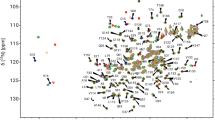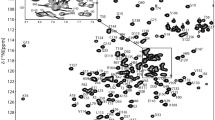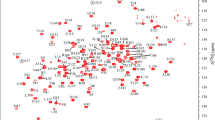Abstract
The Ral proteins (RalA and RalB) are small G proteins of the Ras family that have been implicated in exocytosis, endocytosis, transcriptional regulation and mitochondrial fission, as well as having a role in tumourigenesis. RalA and RalB are activated downstream of the master regulator, Ras, which causes the nucleotide exchange of GDP for GTP. Here we report the 1H, 15 N and 13C resonance assignments of RalA in its active form bound to the GTP analogue GMPPNP. We also report the backbone assignments of RalA in its inactive, GDP-bound form. The assignments give insight into the switch regions, which change conformation upon nucleotide exchange. These switch regions are invisible in the spectra of the active, GMPPNP bound form but the residues proximal to the switches can be monitored. RalA is also an important drug target due to its over activation in some cancers and these assignments will be extremely useful for NMR-based screening approaches.
Similar content being viewed by others
Biological context
The Ral small G proteins are members of the Ras superfamily and are regulated by Ras, which activates guanine nucleotide exchange factors (GEFs) that act on the Ral proteins. The RalGEFs sanction the removal of GDP from the Ral proteins, thereby permitting its replacement by GTP, which is more abundant in the cell (Bodemann and White 2008; Cooper et al. 2013). Once GTP-bound, the Ral proteins are active and can interact with various downstream effectors, including: components of the exocyst complex, Sec5 (Fukai et al. 2003) and Exo84 (Jin et al. 2005); RalBP1 (also known as RLIP76) (Fenwick et al. 2010); the Y-box transcription factor ZONAB (Frankel et al. 2005); and phospholipases C-δ1 (Sidhu et al. 2005) and D1 (Jiang et al. 1995). The Ral proteins regulate a variety of cellular processes through these effector molecules including exocytosis, endocytosis, actin cytoskeletal dynamics, transcriptional activation and mitochondrial fission. In addition, Ral proteins have been implicated in the initiation and regulation of oncogenic transformation of human cells (van Dam and Robinson 2006). The Ral proteins like other small G proteins act as molecular switches, which cycle between GTP bound active and GDP bound inactive states. They contain two dynamic switch regions [switch I (residues 41–51) and switch II (residues 69–81)], which are involved in effector binding and undergo conformational changes upon nucleotide exchange (Milburn et al. 1990). There are two Ral isoforms, RalA and RalB, which have approximately 85% sequence identity and in vitro bind with similar affinities to their effectors (Campbell et al. 2015). In vivo however, RalA and RalB appear to perform distinctive functions in normal cells and to play different roles in tumourigenesis and cancer progression. The sequence differences are mainly within the C-terminal, hypervariable region of RalA and RalB, and indeed all of the residues known to contact effector proteins are conserved (Mott and Owen 2010). There is also a single residue insertion in the loop between helix α3 and strand β5, which, while not contacting effectors directly, is close to the effector binding regions. These differences are likely to determine differential Ral protein interactions with their effector molecules (Campbell et al. 2015; Shipitsin and Feig 2004). Furthermore, the divergent C-terminal region of Ral proteins is also thought to determine their cellular localization (Shipitsin and Feig 2004).
The resonance assignments for RalB·GMPPNP were published in 2007 (Prasannan et al. 2007) but there are no resonance assignments currently available for RalA. Here, we report the backbone and sidechain assignments for RalA bound to the non-hydrolysable GTP analogue, GMPPNP. We also report the backbone amide assignments for the GDP bound, inactive form of RalA.
Methods and experiments
Uniformly 15 N- and 15 N,13C-labelled simian RalA G domain (residues 1–184) containing the activating Q72L mutation was expressed and purified as described earlier (Campbell et al. 2015). The bound nucleotide was exchanged for GMPPNP (Sigma) as described previously (Thompson et al. 1998). Uniformly 15 N and 15 N-13C wild type (wt) RalA G domain (residues 1–184) was also expressed and purified as described above. To prepare a protein sample bound only to GDP, wt RalA was incubated at 25 °C for 16–20 h to allow complete hydrolysis of the bound GTP. HPLC analysis was used to confirm the identity of all bound nucleotides.
NMR samples contained 0.26 mM and 0.45 mM of 15 N- and 15 N,13C-labelled Q72L RalA·GMPPNP respectively or 0.75 mM of 15 N-labelled wt RalA·GDP in NMR buffer (20 mM Tris–HCl, pH 7.6, 150 mM NaCl, 1 mM MgCl2, 0.05% NaN3) with an additional 10% D2O. All NMR spectra were acquired on a Bruker DRX500 spectrometer at 298 K except 13C HSQC, HCCH-TOCSY and 13C-separated NOESY experiments, which were recorded on a Bruker DRX800 at 298 K. The following experiments were recorded on 15 N,13C-labelled Q72L RalA·GMPPNP: HNCA, HN(CO)CA, HNCACB, CBCA(CO)NH, HCCH-TOCSY, 13C HSQC, and 13C-separated NOESY. 15 N HSQC, 15 N-separated TOCSY and 15 N-separated NOESY experiments were recorded on 15 N-labelled samples of both Q72L RalA·GMPPNP and wt RalA·GDP. A 2D homonuclear 1H NOESY was recorded on 0.70 mM unlabelled Q72L RalA·GMPPNP. All NOESY experiments were recorded with 100 ms mixing times. NMR data were processed using AZARA (Boucher, https://www.bioc.cam.ac.uk/azara), and analysed using CCPN Analysis (Vranken et al. 2005).
For Q72L RalA·GMPPNP the backbone assignments were achieved using standard triple resonance methodology (Gardner and Kay 1998).The sidechain resonances were assigned using the triple resonance experiments (HNCACB, CBCA(CO)NH), in combination with 15 N-separated TOCSY and HCCH-TOCSY experiments, as well as 15 N-separated and 13C-separated NOESY. Sidechain resonances of aromatic residues were assigned using the aromatic region of a 13C HSQC and the relevant planes in the 13C-separated NOESY. Assignments were validated by the presence of return peaks in the related 13Cβ planes. The methyl groups of methionine were identified using their strong peaks at distinct chemical shifts in the 13C HSQC and the sign of the crosspeaks in constant time 13C HSQC. Sidechain amide resonances for Asn, Gln and Arg were assigned using the 15 N-separated and 13C-separated NOESY spectra. The 2D homonuclear 1H NOESY was used to identify proton chemical shifts for the bound GMPPNP. The backbone resonances for wt RalA·GDP were assigned with the aid of the assignments of Q72L RalA·GMPPNP, in combination with the 15 N-separated NOESY and TOCSY and 15 N HSQC recorded on both proteins (Clore and Gronenborn 1998a, b; Marion et al. 1989).
Assignments and data deposition
Backbone resonances were never observed for the 11 N-terminal residues (1–11) of RalA. Subsequent electrospray ionisation mass spectrometry (ESI–MS) analysis showed that the N-terminus of RalA undergoes proteolysis in solution. This region is not the part of G-domain of Ral proteins (Bourne et al. 1991) and was similarly absent (and therefore unassigned) in RalB (Fenwick et al. 2009; Prasannan et al. 2007).
The complete backbone assignments were obtained for residues 12–184 of Q72L RalA·GMPPNP except for residues 43–49, which are within switch I, and 68–70, which are in switch II. The statistics for the backbone assignments are shown in Table 1. The 1H–15N HSQC spectrum showing the spectral quality and the assignments is shown in Fig. 1. The switch I (41–51) and switch II (68–81) regions in small G proteins exhibit internal mobility in the active form, on a timescale that makes their assignment problematic (Feltham et al. 1997; Kraulis et al. 1994; Mott et al. 1999). The missing assignments in these regions were therefore not surprising.
Sidechain assignments were achieved for all residues with observable backbone resonances in Q72L RalA·GMPPNP. In addition, sidechains were assigned for residues Thr69 Ala70 in switch II. Outside the two switch regions, aliphatic side-chains for residues 11 to 184 were almost fully assigned except for sidechain carbons of Lys27, Arg176 and Lys179. The 1H and 13C of all proton-bearing aromatic sidechains were fully assigned, except Tyr43 in switch I. Hε/Nε were assigned for Arg108 and Arg135, Hη was assigned for Tyr153 and OH were assigned for Thr31, Ser100, Ser129 and Thr160. All Gln and Asn sidechain NH2 groups were also assigned.
The H1, H2 and H8 resonances of the purine ring and H1′ of the ribose in GMPPNP were assigned using a 2D 1H NOESY spectrum. Assignments of RalA·GMPPNP have been deposited in the BMRB database, accession number 28046.
For wt RalA·GDP, backbone amides of all of switch 1 could be assigned and assignments were missing only for Ala70 and Asn81 in switch II. The statistics for the backbone assignments are shown in Table 1. The 1H–15N HSQC spectrum of wt RalA·GDP showing the spectral quality and the assignments is shown in Fig. 2. Assignments of wt RalA·GDP have been deposited in the BMRB database, accession number 28047.
References
Bodemann BO, White MA (2008) Ral GTPases and cancer: linchpin support of the tumorigenic platform. Nat Rev Cancer 8:133–140
Bourne HR, Sanders DA, McCormick F (1991) The GTPase superfamily: conserved structure and molecular mechanism. Nature 349:117–127
Campbell LJ, Peppa M, Crabtree MD, Shafiq A, McGough NF, Mott HR, Owen D (2015) Thermodynamic mapping of effector protein interfaces with RalA and RalB. Biochemistry 54:1380–1389
Clore GM, Gronenborn AM (1998a) Determining the structures of large proteins and protein complexes by NMR. Trends Biotechnol 16:22–34
Clore GM, Gronenborn AM (1998b) NMR structure determination of proteins and protein complexes larger than 20 kDa. Curr Opin Chem Biol 2:564–570
Cooper JM, Bodemann BO, White MA (2013) The RalGEF/Ral pathway: evaluating an intervention opportunity for Ras cancers. Enzymes 34(Pt. B):137–156
Feltham JL, Dotsch V, Raza S, Manor D, Cerione RA, Sutcliffe MJ, Wagner G, Oswald RE (1997) Definition of the switch surface in the solution structure of Cdc42Hs. Biochemistry 36:8755–8766
Fenwick RB, Prasannan S, Campbell LJ, Nietlispach D, Evetts KA, Camonis J, Mott HR, Owen D (2009) Solution structure and dynamics of the small GTPase RalB in its active conformation: significance for effector protein binding. Biochemistry 48:2192–2206
Fenwick RB, Campbell LJ, Rajasekar K, Prasannan S, Nietlispach D, Camonis J, Owen D, Mott HR (2010) The RalB-RLIP76 complex reveals a novel mode of ral-effector interaction. Structure 18:985–995
Frankel P, Aronheim A, Kavanagh E, Balda MS, Matter K, Bunney TD, Marshall CJ (2005) RalA interacts with ZONAB in a cell density-dependent manner and regulates its transcriptional activity. EMBO J 24:54–62
Fukai S, Matern HT, Jagath JR, Scheller RH, Brunger AT (2003) Structural basis of the interaction between RalA and Sec5, a subunit of the sec6/8 complex. EMBO J 22:3267–3278
Gardner KH, Kay LE (1998) The use of 2H, 13C, 15N multidimensional NMR to study the structure and dynamics of proteins. Annu Rev Biophys Biomol Struct 27:357–406
Jiang H, Luo JQ, Urano T, Frankel P, Lu Z, Foster DA, Feig LA (1995) Involvement of Ral GTPase in v-Src-induced phospholipase D activation. Nature 378:409–412
Jin R, Junutula JR, Matern HT, Ervin KE, Scheller RH, Brunger AT (2005) Exo84 and Sec5 are competitive regulatory Sec6/8 effectors to the RalA GTPase. EMBO J 24:2064–2074
Kraulis PJ, Domaille PJ, Campbell-Burk SL, Van Aken T, Laue ED (1994) Solution structure and dynamics of ras p21.GDP determined by heteronuclear three- and four-dimensional NMR spectroscopy. Biochemistry 33:3515–3531
Marion D, Driscoll PC, Kay LE, Wingfield PT, Bax A, Gronenborn AM, Clore GM (1989) Overcoming the overlap problem in the assignment of 1H NMR spectra of larger proteins by use of three-dimensional heteronuclear 1H–15N Hartmann-Hahn-multiple quantum coherence and nuclear Overhauser-multiple quantum coherence spectroscopy: application to interleukin 1 beta. Biochemistry 28:6150–6156
Milburn MV, Tong L, deVos AM, Brunger A, Yamaizumi Z, Nishimura S, Kim SH (1990) Molecular switch for signal transduction: structural differences between active and inactive forms of protooncogenic ras proteins. Science 247:939–945
Mott HR, Owen D (2010) RLIP76 (RalBP1): The first piece of the structural puzzle. Small GTPases 1:157–160
Mott HR, Owen D, Nietlispach D, Lowe PN, Manser E, Lim L, Laue ED (1999) Structure of the small G protein Cdc42 bound to the GTPase-binding domain of ACK. Nature 399:384–388
Prasannan S, Fenwick RB, Campbell LJ, Evetts KA, Nietlispach D, Owen D, Mott HR (2007) 1H, 13C and 15N resonance assignments for the small G protein RalB in its active conformation. Biomol NMR Assignments 1:147–149
Shipitsin M, Feig LA (2004) RalA but not RalB enhances polarized delivery of membrane proteins to the basolateral surface of epithelial cells. Mol Cell Biol 24:5746–5756
Sidhu RS, Clough RR, Bhullar RP (2005) Regulation of phospholipase C-delta1 through direct interactions with the small GTPase Ral and calmodulin. J Biol Chem 280:21933–21941
van Dam EM, Robinson PJ (2006) Ral: mediator of membrane trafficking. Int J Biochem Cell Biol 38:1841–1847
Vranken WF, Boucher W, Stevens TJ, Fogh RH, Pajon A, Llinas M, Ulrich EL, Markley JL, Ionides J, Laue ED (2005) The CCPN data model for NMR spectroscopy: development of a software pipeline. Proteins 59:687–696
Acknowledgements
This work was funded by Cambridge Commonwealth, European and International Trust (CCEIT) and Higher Education Commission of Pakistan (HEC) to AS and MRC Project Grants (G0700057 and MR/J007803/1) to DO and HRM. AS is grateful to the Cambridge Philosophical Society for additional support.
Author information
Authors and Affiliations
Corresponding author
Additional information
Publisher's Note
Springer Nature remains neutral with regard to jurisdictional claims in published maps and institutional affiliations.
Rights and permissions
Open Access This article is licensed under a Creative Commons Attribution 4.0 International License, which permits use, sharing, adaptation, distribution and reproduction in any medium or format, as long as you give appropriate credit to the original author(s) and the source, provide a link to the Creative Commons licence, and indicate if changes were made. The images or other third party material in this article are included in the article's Creative Commons licence, unless indicated otherwise in a credit line to the material. If material is not included in the article's Creative Commons licence and your intended use is not permitted by statutory regulation or exceeds the permitted use, you will need to obtain permission directly from the copyright holder. To view a copy of this licence, visit http://creativecommons.org/licenses/by/4.0/.
About this article
Cite this article
Shafiq, A., Campbell, L.J., Owen, D. et al. NMR resonance assignments for the active and inactive conformations of the small G protein RalA. Biomol NMR Assign 14, 87–91 (2020). https://doi.org/10.1007/s12104-019-09925-7
Received:
Accepted:
Published:
Issue Date:
DOI: https://doi.org/10.1007/s12104-019-09925-7






